Narenjestan-e Ghavam (Qavam House) | Shiraz Must-Visit Attractions
Iranian gardens are a defining element of the country's architectural landscape, with examples found across the nation. Narenjestan Garden, also commonly referred to as Qavam Garden, is among the most exquisite sites in Shiraz.
This historical estate dates back to the Qajar era and is named for the abundance of orange trees within its grounds. Qavam House is one of Shiraz's most stunning attractions, and no visit to the city would be complete without experiencing its beauty. The garden, though modest in size compared to other historical gardens, is filled with lush orange trees, and features a striking mirrored mansion with colorful glass windows, a tranquil pond, and an atmosphere of serenity that deeply resonates with visitors.
History of Narenjestan-e Ghavam Garden in Shiraz
During the Qajar era, the Qavam family held significant power in Fars, leaving behind many notable structures in Shiraz. Among these, Narenjestan-e Ghavam stands out, along with other notable estates such as Afif Abad Garden, Fat'h Abad Garden, and Bagh Kalantar. Over time, additional structures were added to the Narenjestan-e Ghavam complex, enhancing its grandeur.
Construction of the Narenjestan-e Ghavam Garden began in 1257 AH, during the reign of Naser al-Din Shah Qajar, initiated by Muhammad Ali Khan Qavam-ul-Mulk after the death of his father, Qawamul-Mulk I. However, Muhammad Ali Khan passed away before its completion, and the project was carried forward by his son, Mohammad Reza Khan Qavam-ul-Mulk III, who completed the main building by 1261 AH. The garden and mansion continued to be adorned with interior decorations until 1298 AH. This estate served as a political and military hub, hosting meetings with representatives of foreign governments.
In 1966, Ibrahim Qavam-ul-Molk generously donated Narenjestan Garden to Shiraz University. Since then, it has become one of the city's most prominent attractions, drawing visitors from around the world.
The Qavam Family

To fully appreciate the significance of Narenjestan-e Ghavam, it is essential to delve into the history of the Qavam family. The story begins in the Zand period, long before the Qavam family or Narenjestan Garden existed. During this time, a man named Haj Ebrahim Khan, known as Etemad-ud-Dawlah Shirazi, played a pivotal role in the downfall of Lotf Ali Khan, the last ruler of the Zand dynasty. His betrayal facilitated Agha Mohammad Khan Qajar's rise to power, who subsequently appointed Haj Ebrahim Khan as the governor of Shiraz. Haj Ebrahim Khan positioned his associates in high-ranking government roles, establishing a strong political presence.
This influence persisted until the reign of Fath Ali Shah, who grew suspicious of Ebrahim Khan's power and ordered his execution, along with that of his family. Remarkably, only Ali Akbar, one of Ebrahim Khan's sons, survived due to a bout of illness that kept him away from the massacre. Later, when Fath Ali Shah visited Shiraz, he recognized the injustice he had committed and, to make amends, bestowed upon Ali Akbar the title of Qavam al-Mulk, appointing him as the governor of Shiraz. This marked the beginning of the Qavam family's long-standing influence in the region.
The Architecture of Narenjestan-e Ghavam

Narenjestan-e Ghavam Garden, commonly known as "Bagh Narenjestan" due to the abundance of orange trees, is also referred to as Qavam-ul-Molk House or Qavam House Garden by many. This historic site is part of a larger complex, which includes the Zinat Al-Molk Historical House. These two buildings are positioned wall-to-wall, forming a unified structure. The main building of Narenjestan Garden serves as the "outer building," while the Zinat Al-Molk House acts as the "inner building," with both structures interconnected through a basement. Historically, the outer building was designated for administrative and judicial functions, including meetings with guests. In contrast, the inner building was reserved for women, children, and servants.
Artistic Elements in Narenjestan-e Ghavam
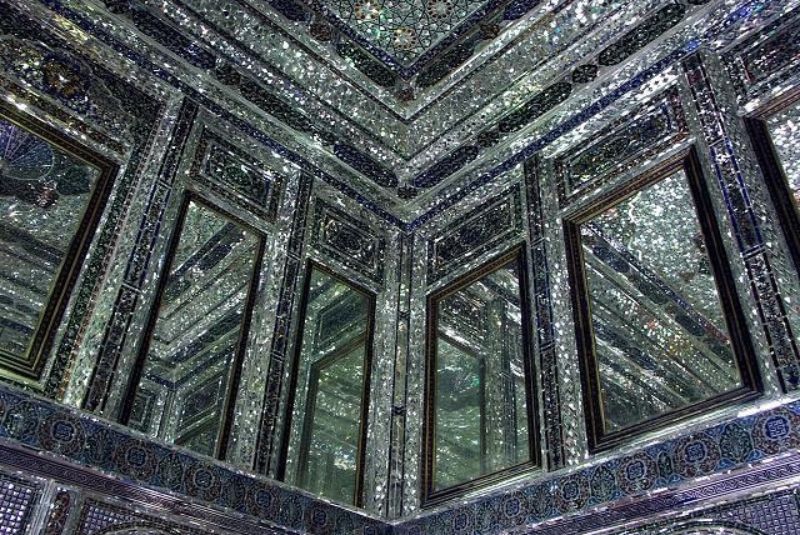
The Narenjestan-e Ghavam Garden is adorned with numerous artistic masterpieces across its walls, ceilings, and windows, capturing the admiration of all visitors. The mansion showcases seven traditional Iranian arts: plastering, mirror work, mosaic work, inlay work, traditional paintings, brickwork, and sculpture. These artistic features are among the key attractions that draw tourists to this site. Additionally, the garden's orange trees contribute to the area's charm, especially in spring, when the scent of orange blossoms fills the air, creating an unforgettable experience for those strolling through the garden.
Architectural Layout and Style

Narenjestan-e Ghavam Garden in Shiraz stands out as one of the most unique and visually stunning Iranian gardens, covering an area of 3,500 square meters. The main building, occupying 940 square meters, is strategically positioned on the north, east, and south sides of the garden. The principle of symmetry is a defining feature of the garden's design. The central porch, known as the mirror hall, is flanked by harmoniously arranged rooms on either side. Upon entering the garden, visitors are greeted by a symmetrical layout featuring rows of palm and orange trees, with a central pathway leading directly to the main building.
The architectural style of the Qavam mansion is a blend of Qajar influences and elements from the Zandiye period. The structure incorporates a combination of tiling, mirroring, carving, and plastering techniques. The porch walls are decorated with intricate stucco, a hallmark of Qajar-era artistry, while the hall's floor is paved with blue and white tiles. The side rooms' ceilings are predominantly wooden, showcasing exquisite carvings. The main room adjacent to the porch features a mirrored ceiling that captivates every visitor's attention.
Main Entrance and Garden Area
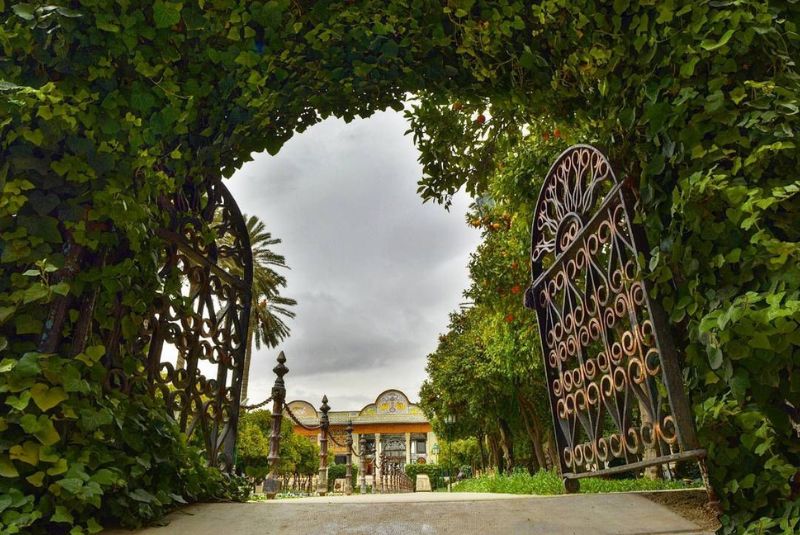
The main entrance to the Narenjestan-e Ghavam Garden is distinguished by a teak wooden door, adorned with inlays, that opens to the south. This door leads to a vestibule, a covered space that connects the alley to the courtyard. The vestibule, which is ornately decorated with tiles, bricks, and gypsum muqrans, guides visitors through two corridors into the garden area.
Upon entering the garden, visitors find themselves in a vast space, enclosed during the Qajar period, that stretches between the north and south buildings. This area, lined with orange trees, directs visitors toward the mansion. The garden's design ensures that every turn offers a visual feast of colors and beauty. The path through the garden leads to a large rectangular pond, which mirrors the grandeur of the Qavam house, enhancing the dreamlike atmosphere.
The Main Hall of Narenjestan-e Qavam Mansion
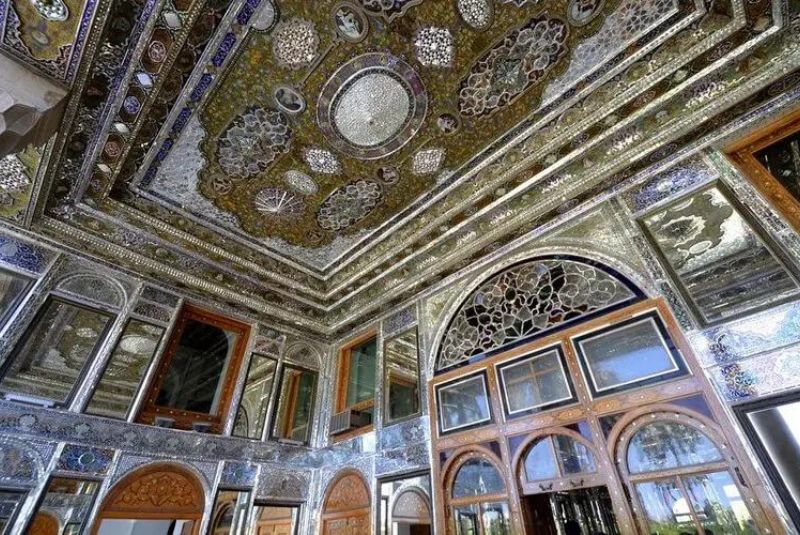
The main mansion of Narenjestan-e Ghavam is a two-story structure with a basement and a large veranda. Designed in the architectural style of the Zandiye period, the mansion is characterized by its grandeur and intricate decorations, exemplifying the peak of Qajar-era art. The mansion houses 20 rooms, all interconnected in a surprising manner, except those on the eastern side. Historically, the basement served as an armory and storage for beans, herbs, and rice.
The Porch of the Mansion
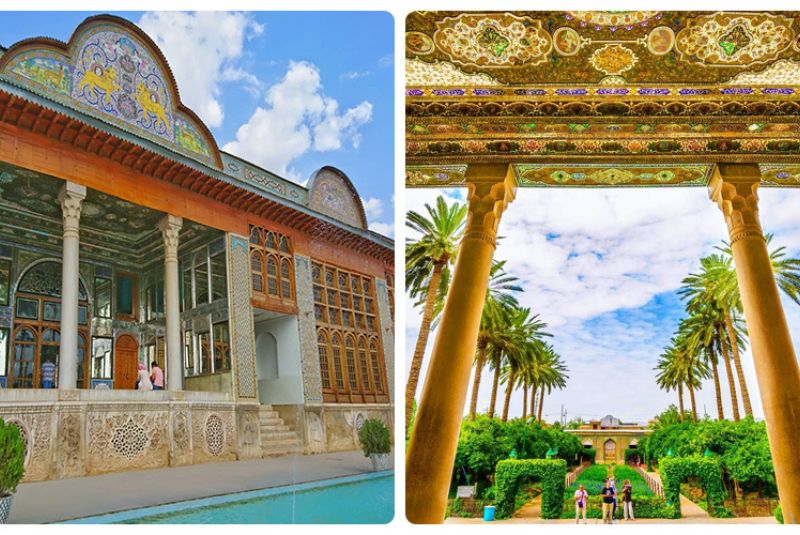
The porch of the Narenjestan-e Ghavam mansion is a standout example of Qajar-era architecture. It features two cylindrical marble columns that face the pond and the garden courtyard. These columns, with their intricately carved capitals, contribute to the porch's striking appearance.
What sets this porch apart from others is the array of unique paintings, mirrors, and carvings that adorn it. The ceiling is decorated with a large medallion painting at its center, surrounded by six beautifully crafted oval landscapes. The space around these paintings is filled with intertwining designs of flowers, plants, animals, and various landscapes. Most of the mansion's and porch's paintings are the work of Lotf Ali Khan, a renowned Qajar-era artist. The porch's ceiling border is further enhanced by wallpaper and colored paper imported from Europe.
The porch's walls feature carvings of Achaemenid soldiers, mythical creatures, and other symmetrical designs. The mirror work on the porch is exceptionally detailed, adding to its allure.
Mansion Rooms

On either side of the porch are two staircases leading to the mansion's interior and bedroom, known as Baharkhab. This open space overlooks the garden, providing a noble view of Narenjestan. The main room, adjacent to the porch, is a spectacle of mirrored work, known as the Hall of Mirrors or King's Room, which was reserved for the ruler, his relatives, and close guests. The room's ceiling, walls, and every surface are covered in mirrors, creating a dazzling effect reminiscent of an intricately designed Persian carpet.
The room is complemented by crescent-shaped wooden doors and windows with sash windows, which allow colored light to enter the room. The interplay of light with the mirrors creates a mesmerizing atmosphere that is best appreciated in person. The colored glass in these windows was imported from Europe, adding to the room's uniqueness.
At the end of the hall, a staircase leads to the second floor, which consists of four rooms. Two of these rooms overlook the porch and were historically used to accommodate guests.
Gachineh Bath
The Gachineh Bath, built in 1300 AD, is one of Shiraz's five historic baths. It features several sections, including the private bath of Qavam al-Sultaneh, and is connected to the Narenjestan-e Ghavam mansion via a tunnel.
Narenjestan-e Ghavam Garden Kitchen
Located on the eastern side of the building, the garden's kitchen includes a small courtyard, a stone pond with a fountain, and several rooms. Historically, this area housed the mansion's staff.
Diwan Khaneh and Qavam School House
The Diwan Khaneh, located on the south side of the garden, features six rooms. The wooden columns here are decorated with inlays, and the flooring consists of white and blue tiles. The building also boasts beautiful plasterwork and intricately carved stone windows. The Qavam School House is located in the eastern part of the complex and has undergone renovations in recent years.
House of Araghies
The House of Araghies is an architecturally significant part of the Narenjestan-e Ghavam mansion, situated in the mansion's eastern area. Initially known as the Maktabkhaneh mansion, it was later used by families for Aragh-giri (distillation), leading to its current name. Although the structure has suffered considerable damage over the years and requires restoration, it remains an important part of the complex. The building is currently owned by Shiraz University and is not open to the public.
South Building
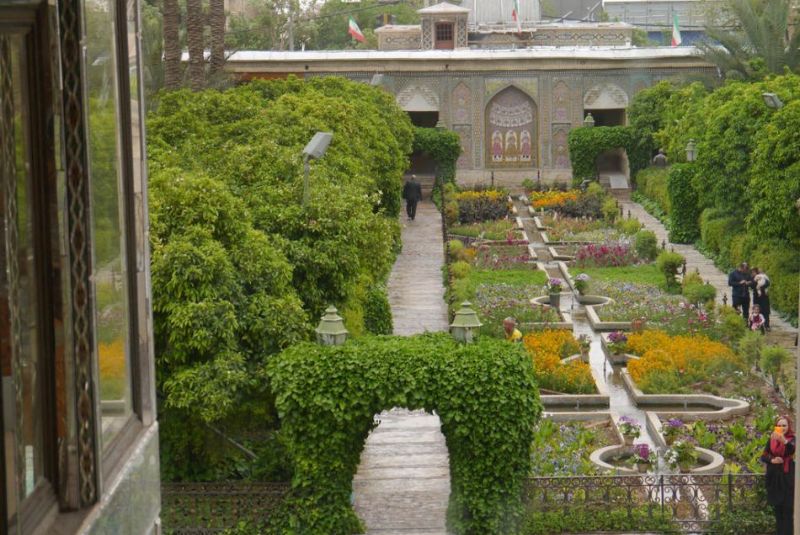
The south buildings of Qavam House include two corridors, one leading to the main courtyard through a vestibule at the garden entrance. These corridors are flanked by two full-length porches with four inlaid wooden columns and two semi-columns each. The porch walls are adorned with beautiful plasterwork, and the floors are tiled with white and blue tiles.
The roof of the eastern porch combines mirror work and painting on wood. Unfortunately, a fire caused irreparable damage to this roof, making restoration impossible. Five delicately carved stone windows act as skylights in front of the porches. The southern building features six rooms, which were used as government offices in the past. The porches served as waiting rooms for clients.
The central archway of the southern building, accompanied by two smaller arches, showcases Zandiye-style tile art. The archway displays images of three servants in period clothing, each holding different items. The surrounding tiles depict hunting scenes and other motifs like Rostam and the White Devil. The red marble plinths are intricately carved with images of Persepolis. This building also connects to the Narenjestan-e Ghavam basement through a staircase.
Basements
A unique feature of Qavam House is its extensive basement, which stretches from the southern to the northern parts of the garden. This vast underground area is far from ordinary, representing an important element of the site's architecture.
The garden has four entrances to the basement, two of which are sealed with stones. The basement's structure is consistent throughout, with the last renovation of its brickwork taking four years before the revolution. Historically, the basements of noble houses were interconnected, and this basement directly links to the main mansion.
When is the Best Time to Visit Qavam House?
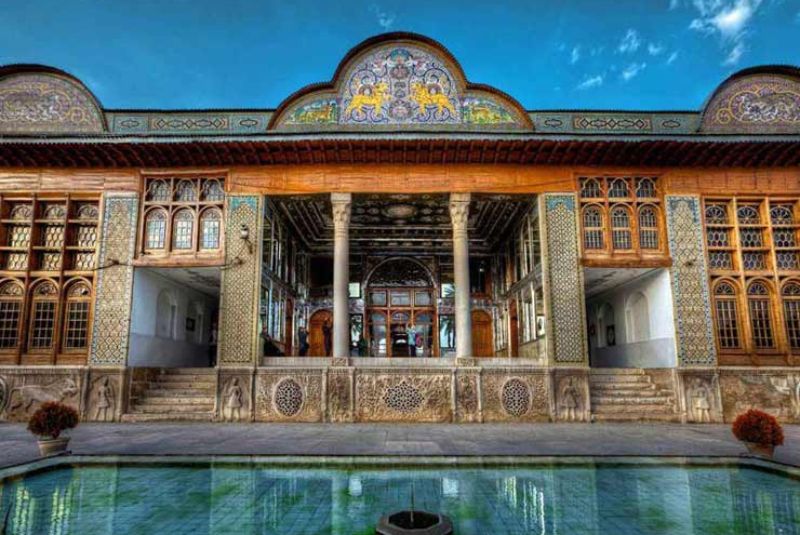
Shiraz is particularly enchanting in the spring, with the beauty of the season adding a special charm to the city. While spring is lovely in many places, it is especially captivating in Shiraz. The ideal time to visit Narenjestan-e Ghavam is during May, when the air is filled with the fragrance of blooming orange blossoms, and the weather is exceptionally pleasant. However, it is important to note that this time of year also attracts many tourists, making Narenjestan-e Ghavam more crowded.
For those seeking a quieter experience, Qavam House offers its own unique allure throughout the rest of the year. Shiraz has something to offer visitors in every season, so there’s no need to restrict your visit to just one time of year.
Where is Narenjestan-e Ghavam?
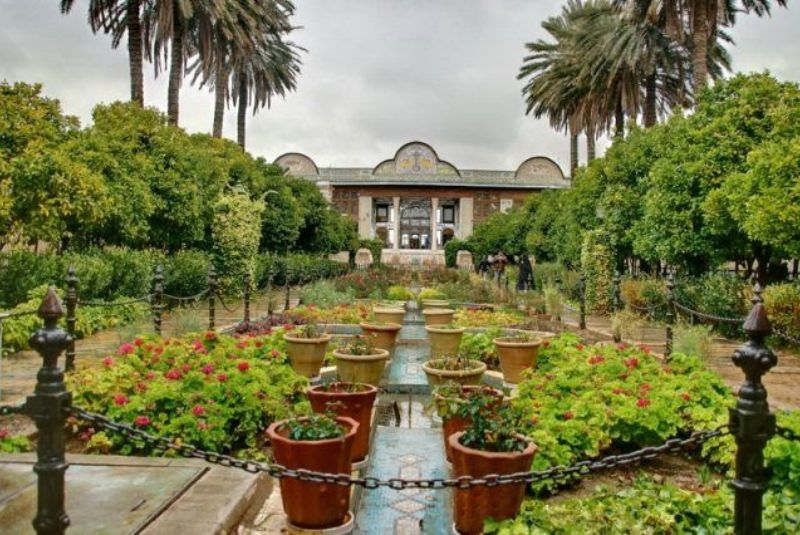
Narenjestan-e Ghavam is located in Shiraz, Fars Province, specifically on Lotf Ali Khan Zand Street. The site is easily accessible via public transportation, including buses and the subway.
Visitors can explore Narenjestan-e Ghavam daily from 8:00 AM to 9:00 PM, except on official holidays.
Qavam Garden Nearby Attractions

After exploring Narenjestan-e Ghavam, there are several other attractions nearby that are worth visiting:
- Hafez Tomb (Hafiziya Complex): Located in the northern part of Shiraz, this site is the final resting place of the celebrated poet Hafez. The complex, which is both a cultural and historical site, includes a museum and is situated in a historic cemetery. The restoration of the Hafeziya Complex was overseen by André Godard, a French architect and archaeologist.
- Karim Khan Citadel: This historic fortress, dating back to 1180 AH, is one of the most famous landmarks from the Zand era and is recognized as a national heritage site in Iran. The citadel, which has served both military and residential purposes, was originally constructed by order of Karim Khan Zand.
Additional nearby attractions include:
- Khan School: 700 meters away
- Pars Museum:4 kilometers away
- Shahcheragh Shrine: 2 kilometers away
- Zinat al-Molk House: Just a 1-minute away
- Forough Al-Molk House:7 kilometers away
- Nasir al-Mulk Mosque: 600 meters away
- Vakil Bazaar:6 kilometers away
- Vakil Bathhouse:4 kilometers away
These sites provide a rich cultural experience, complementing a visit to Qavam House.

Final Takeaway
Narenjestan-e Ghavam is a place of rich diversity, with each section offering its own unique story and marvels that are best experienced in person. Annually, this historic garden and its stunning architecture draw numerous visitors, both from within Iran and abroad, especially during the spring. The garden, with its grand structure, stands as one of the most captivating remnants of the Qajar era, showcasing a blend of Qajar and Zand architectural styles. For the most enchanting experience, we highly recommend visiting Qavam House in the spring when its beauty is at its peak.
Share your story!
Comment below and let us know about your Experience.
Your story inspires others!


Comment
Leave a Comment